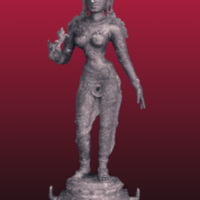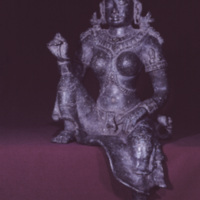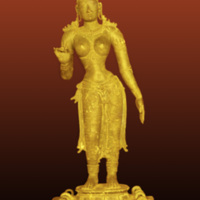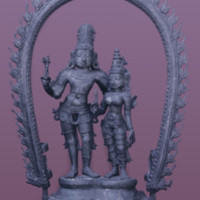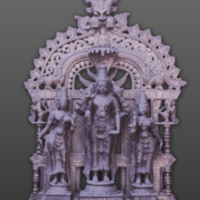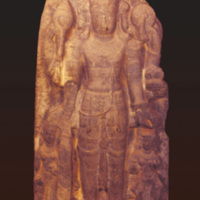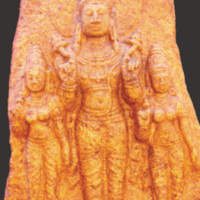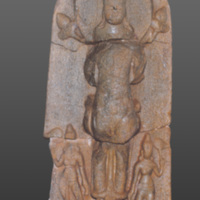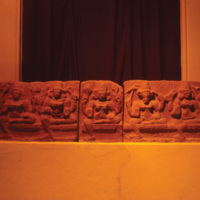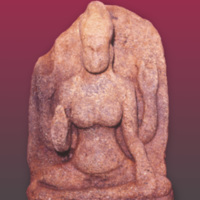Main Menu
AORC Libraries
Browse Archive Items (16 total)
Parvati
Description: This bronze image of Parvati was also found buried near a Siva devalaya at Polonnaruva. It was discovered in 1987 during excavations connected with the Cultural Triangle Project. The image presently displayed at the Colombo National Museum may be attributed to a period around the 12th century A.D.
Contributor: Co-Author: Seneviratna, Harsha
Collection: Women in Sri Lankan Sculpture and Painting
Tags: AISLS, Goddesses in Hindu Worship, ICES, PDWESLSP
Parvati
Description: Another example of a single bronze image of Parvati of about the Cola period found buried together with other Hindu statues is this seated bronze figure. It was found about 300 yards from the Jetavanarama dagoba during the 1984 excavations. The statue is presently stored at the site Museum of the Jetavanarama Cultural Triangle Project in Anuradhapura.
Contributor: Co-Author: Seneviratna, Harsha
Collection: Women in Sri Lankan Sculpture and Painting
Tags: AISLS, Goddesses in Hindu Worship, ICES, PDWESLSP
Parvati as Sivakamasundari
Description: Instances are not rare when Siva and Parvati bronzes were separately cast and placed side by side. The goddess as Sivakamasundari represented by this standing bronze, probably of the Cola period, from the Archaeological Museum, Anuradhapura, Sri Lanka was found buried in a pit behind one of the Siva devalayas at Polonnaruva, Sri Lanka, It is reported that even in this hideout she was found placed in a position of attendance on the male deity.
Contributor: Co-Author: Seneviratna, Harsha
Collection: Women in Sri Lankan Sculpture and Painting
Tags: AISLS, Goddesses in Hindu Worship, ICES, PDWESLSP
Parvati, consort of Siva
Description: It is more usual for a single consort, Parvati, to be associated with Siva images as seen in this bronze representation found in the Colombo National Museum. Originally from one of the Siva devales at Polonnaruva, Sri Lanka, it is perhaps a work of the Polonnaruva period.
Contributor: Co-Author: Seneviratna, Harsha
Collection: Women in Sri Lankan Sculpture and Painting
Tags: AISLS, Goddesses in Hindu Worship, ICES, PDWESLSP
Goddesses, consorts of Vishnu
Description: Datable to about the 12th century A.D. on stylistic grounds, this bronze representation of Vishnu and his consorts, from the Colombo National Museum is framed by a tiruvasi or an arch of flames.
Contributor: Co-Author: Seneviratna, Harsha
Collection: Women in Sri Lankan Sculpture and Painting
Tags: AISLS, Goddesses in Hindu Worship, ICES, PDWESLSP
Two goddesses, consorts of Vishnu
Description: This 11th century stone relief of Vishnu with his two female companions, kept in the Colombo National Museum. Its original find spot was a Devalaya (Hindu shrines) in Polonnaruva, Sri Lanka.
Contributor: Co-Author: Seneviratna, Harsha
Collection: Women in Sri Lankan Sculpture and Painting
Tags: AISLS, Goddesses in Hindu Worship, ICES, PDWESLSP
Two goddesses, consorts of Surya.
Description: This stone relief of Surya, flanked by two female companions and datable in the Polonnaruva period was discovered near a Siva Devale, Polonnaruva, Sri Lanka in 1985, during explorations connected with the Polonnaruva Cultural Triangle Project and is now housed in the site Museum. The proportionate disparity as between the male and female figures is not very great.
Contributor: Co-Author: Seneviratna, Harsha
Collection: Women in Sri Lankan Sculpture and Painting
Tags: AISLS, Goddesses in Hindu Worship, ICES, PDWESLSP
Two Goddesses, consorts of Surya
Description: It is as the female companions of gods that Hindu goddesses often received veneration. Surya or the sun god is usually accompanied by two female companions as in this stone image exhibited in the galleries of the Archaeological Museum at Anuradhapura. The female companions bearing chamaras are of very diminutive size. A date in the late Anuradhapura period may be suggested for this sculpture.
Contributor: Co-Author: Seneviratna, Harsha
Collection: Women in Sri Lankan Sculpture and Painting
Tags: AISLS, Goddesses in Hindu Worship, ICES, PDWESLSP
Frieze of Hindu goddesses, the Seven Mothers
Description: This frieze of the Saptamatrkas, made up of three stone slabs, is seen at the Colombo National Museum. They can be identified as the female companions of Brahma, Siva, Vishnu and some of his incarnations and the Goddess Camunda. Originally found among the ruins of Siva Devala No. 5 at Polonnaruva, Sri Lanka, the sculpture can be ascribed to the 11th or 12th century A. D.
Contributor: Co-Author: Seneviratna, Harsha
Collection: Women in Sri Lankan Sculpture and Painting
Tags: AISLS, Goddesses in Hindu Worship, ICES, PDWESLSP
4-armed Hindu goddess, one of the Seven Mothers
Description: A goddess among the Saptamatrka, also from Mahakandarava, Sri Lanka, this stone image is presently housed in the Archaeological Museum at Mihintale, Sri Lanka. Dated in the 11th century A.D.
Contributor: Co-Author: Seneviratna, Harsha
Collection: Women in Sri Lankan Sculpture and Painting
Tags: AISLS, Goddesses in Hindu Worship, ICES, PDWESLSP



